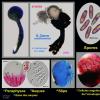
18-03-2024 14:41
• Polydesmia: Distinctive macro, mostly on strom

16-03-2024 20:17
 éric ROMERO
éric ROMERO
Bonjour, J'ai besoin de votre aide pour ce Mollis

17-03-2024 20:58
Stefan JakobssonFor a few days we had temperatures above freezing

17-03-2024 18:00
Margot en Geert VullingsWe found these black fungi on a fallen twig of mos

17-03-2024 08:43
Joaquin MartinHi,I found this Ascomycete on Fagus wood.Spore siz

10-03-2024 19:57
 Thierry Blondelle
Thierry Blondelle
HelloI need to progress with the key of Cheilymeni

15-03-2024 21:00
 Robin Isaksson
Robin Isaksson
Spores 11-13 x 4-5 um, aseptateAsci 53-60 x 10 cro
Asco inconnu
Roland Labbé,
18-02-2009 21:54
Voici une planche d'un Asco qui m'est ocmplètement inconnu, possiblement un Plectomycète ?
Merci de bien vouloir me renseigner sur l'espèce en question.
Détails :
Date de récolte: 2009 / 02 / 17
Substrat : culture intérieure sur bûche décomposée d’érable rouge, possiblement sur très vieux Hypoxylon ?
Sporée absente
Cleisthothèce probable porté par un pied ?
Spores cylindriques, lisses, avec 2 grosses guttules polaires, apparemment non septées, possiblement avec un étranglement central à maturité, 10-12 x 3 µm, 10,6 x 3 µm en moyenne (10 spores), Q = 3,53
Asques à 8 spores bisériées, avec appareil apical non amyloïde, 50-65 x 6-8 µm
Paraphyses longuement fusoïdes-lancéolées, à paroi très mince difficile à observer, possiblement septées vers la base, hyalines, dépassant les asques de ± 30 µm
David Malloch,
19-02-2009 02:22

Re:Asco inconnu
This looks like a perithecium of one of the Diaporthaceae. The apparent stalk may be a long perithecial neck like in species of Gnomonia. The asci do not look like they belong to a plectomycete because they are elongated and appear capable of forcible spore discharge. Is it possible that the perithecium was removed from a stromatic group as in Cryptodiaporthe?

